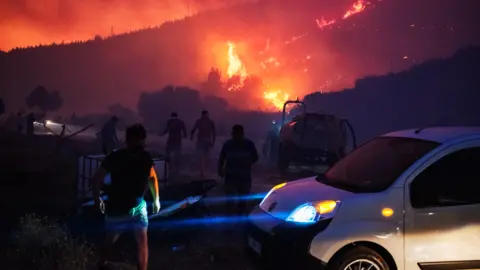BBC News
 Getty image
Getty imageTwo people died in Italy as the temperature rose in the intense heat of Europe.
In Bologna, a 47 -year -old boy died after being sick at the construction site, and a 70 -year -old man was reported to have drowned during the flash flood at a resort in tourists in the west of Turin.
In other places on the continent, tens of thousands of people were evacuated due to the forest fire in the western Turkish, and the top of the Eiffel Tower in Paris was closed by heat wave.
Some of Spain and Portugal recorded temperatures in June, 46C is registered in EL Granado in southwestern Spain, and the day after the record in MORA in central Portugal.
Spain’s AEMET meteorological agency said that several places on the Iberian Peninsula accounted for 43C, but the temperature was offset from Thursday.
The night temperature was recorded on Tuesday overn this night and recorded 28C in Seville and 27C in Barcelona.
In Türkiye, rescuers have evacuated more than 50,000 people in the western Izmir because rescuers have continued to launch hundreds of wildfires recently decomposed.
A fire broke out through part of Bilecik, Hate, Sakarya and Manisa.
Ibrahim Yumakli Forestry Minister said that the emergency team has responded to 263 forest fires nationwide over the past three days.
 Getty image
Getty imageIn France, many cities have experienced the most popular nights and low on Monday, but the predictors said that the heat wave should reach its peak on Tuesday.
Climate Secretary Agnès Pannier-Runacher called it “unprecedented” situation.
For the first time in five years, the Paris region activated red alarms with 15 other French regions. The Ministry of Education said that 1,350 public schools would be partially or completely closed on Tuesday.
On Sunday, 46.6 C (115.9F) was registered in Mora, Portugal, about 60 miles east of Lisbon. Portuguese weather officials were trying to make sure they showed a new record in June.
In Italy, Tuscana area has increased hospital hospitals by 20%.
The Italians in 21 cities out of 27 cities received the highest heat alarms, and 13 areas, including Lombardy and Emilia, recommended not to adventure from outside for the most popular periods.
In Lombardy, working outdoors was banned from 12:30 to 16:00 on the construction site, roads and farms on hot days until September.
Greece’s temperature has been approaching 40c for several days, and forest fires have been struck by several coastal villages near the capital Athens to destroy the house and forced people to evacuate.
Some of the England were ashamed of the hottest June on Monday.
Today’s highest British temperature was recorded at 33.1C in Heathrow Airport in London. MCLE Blun, meanwhile, recorded the temperature of 32.9c, the most popular opening day in tennis tournaments.
German weather services warned that the temperature could reach almost 38C on Tuesday and Wednesday.
The heat wave of the Line lecture has lowered the level of the Line River, the main transport route. It can limit the amount of cargo ships and create cargo costs.
Countries inside and outside the Balkans have begun to cool down, but they are struggling with intense heat. Forest fires were also reported in Montenegro.
 Getty image
Getty imageThe heat wave is a potential health problem, but it also affects the environment. The higher temperature of the Adriatic Sea encourages invasive species such as toxic lions, while also causes additional stress in alpine glaciers that are already decreasing at record speeds.
Volker Turk, the UN Human Rights Director, warned that Monday’s heat wave emphasized the necessity of climate adaptation as it moved away from practices and energy sources, such as fossil fuels, the main cause of climate change.
“The temperature rises, sea, floods, droughts and forest fires threaten our rights to our lives, health, clean, healthy and sustainable environments,” he told the UN Human Rights Board of Directors.
According to the UN’s climate change, the heat wave is becoming more common due to climate change in which humans are triggered.
As the earth continues to warmer, the extreme hot weather will occur more often and more intense.
Richard Allan, a professor of climate science in the UK, explained that if the greenhouse gas level rises, the earth is becoming more difficult to lose excessive fever.
“Warm and thirsty atmosphere is more effective for soil drying, which is being strengthened, and medium -level heat events are extremely extremely extremely extremely.”




